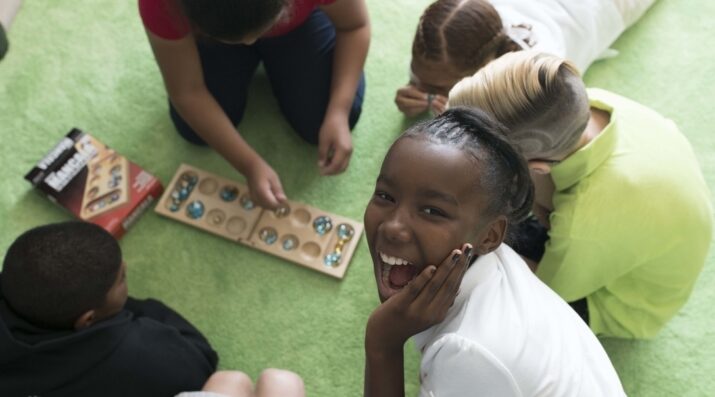Designing for Equity
Children Are Individuals. We all succeed when we see them this way.
Topics

Together, educators are doing the reimagining and reinvention work necessary to make true educational equity possible. Student-centered learning advances equity when it values social and emotional growth alongside academic achievement, takes a cultural lens on strengths and competencies, and equips students with the power and skills to address injustice in their schools and communities.
Thrive Public Schools uses 4 strategies to prepare students for a constantly changing, colorful, and complex world, and the specific needs of the San Diego workforce of the future.
From the day they are born, we tell our children they are special. And it’s true. Every child has something unique to offer the world. In today’s constantly changing, colorful, and complex world, helping students develop their varied talents and interests is the best way to ensure that they have the tools they need to become successful adults. And yet, how often is personalized learning the promise of public education?
The fact is traditional public education, which was built on a one-size-fits-all industrial model, is missing the mark in preparing students for our new world. According to the San Diego County Office of Education, only 26 percent of our local students acquire a four-year degree by the age of 24. If you compare that statistic with the fact that Georgetown University predicts that 65 percent of jobs in 2020 will require a college education, you being to notice a devastating gap. Even in the best-case scenario, 39 percent of San Diego jobs will be unavailable to our future local workforce.
This information becomes even more disheartening when we think about the fact that biotech, engineering, and defense are the three fastest growing job sectors in San Diego, and that most jobs in these sectors require a STEM college degree.
This is not a sustainable path. As public school educators, we have a responsibility to reimagine how we are preparing our students for their futures. We need to rupture these statistics, and we need to do so now.
For Thrive, social emotional learning includes a personalized approach to student discipline, explorations of identity, and field trips that expose students to new communities.
Thrive Public Schools is actively seeking to close the opportunity and achievement gap in education. We do this by joining our children where they live. We embrace their diversity. Thrive purposefully first operates in communities identified by census data as being “highly distressed” or “low income” and then makes sure the quality of education draws in families from around the county. Our demographics confirm this commitment: currently over 18 percent of our student community receives Special Education services, compared to a district average of 11 percent. Sixty-two percent of our students live at or below the poverty line, and over half of them will be the first in their family to graduate college. We serve families from over 40 Southern California zip codes. We are excited by these numbers. They tell us we are doing worthy work, especially with over 1,300 families applying for enrollment just this last year.
It can be challenging to merge the priorities, attitudes, and hearts of diverse families into a single community, but the outcome is priceless. Our children learn from each other, they learn to accept those who live and believe differently from themselves, and we are convinced that our larger community will benefit from the empathetic, insightful adults they will become.
Through our work, we have learned a lot both about what to do and what not to do; here are four strategies we use in our work to prepare students for the San Diego workforce of the future which we want to share with our education community.
1. Instilling Curiosity
If our students are to be successful in the world they will graduate into, they need to have a thirst for knowledge. We push our students to constantly ask, “Why?” Why is artificial Intelligence a powerful technology for our futures? Why does traffic exist? Why are there homeless people and what can we do to help?
Our students engage in the study of these worthy problems with hands-on, minds-on projects. We show them how what they are learning in their classrooms intersects with the real world. We teach them to be discerning creators and consumers of information. This is one way we are ensuring that the next generation will succeed and leave the world a better place than they found it. If we teach them to love learning and the challenge of working to solve some of our world’s biggest problems, our students will have the drive to push through most academic challenges that come their way.
2. Personalize Student Learning Toward Proficiency
Over the past five years, we’ve seen a huge increase in the availability of adaptive learning programs for schools. These tools support diverse school populations because students can digest information at their own pace. They also give educators the data to build intervention groups and challenge students who are ready for more rigorous content. With small group instruction and purposeful technology in the classroom, teachers can meet students at their level, which keeps all students engaged in their learning. As a supplement to standards-based core curriculum and the exploration of worthy problems, students receive targeted academic support through online learning programs (OLPs) making for a holistic and personalized learning path. Some of our favorite OLPs include: ST Math, Zearn, Freckle, Next Gen Math, Lexia, ThinkCerca, StudySync, Achieve3000, NewsELA, Learning A-Z, RazKids, BrainPop, and Prepworks.
3. Make Data Meaningful
We live in an age of information which is both a blessing and a curse. Real time data is critical for educators to ensure each individual student is getting the learning they need. It allows us to quickly intervene to help a student who is struggling with the material. The challenge is cutting through the clutter to find the information that best informs us on how to support our students.
At Thrive, we have recently renewed our commitment to classroom ‘checks for understanding.’ Our teachers work to ensure that students are truly learning what they set out to teach. We believe that checks for understanding are a foundational metric for analyzing student progress.
For schoolwide data, we use a norm-referenced measure of student growth (NWEA MAP). This data helps us ensure that even our most vulnerable students who haven’t yet met state proficiency are meeting growth targets for reading and mathematics. We also use MAP data to identify students who need intensive academic intervention.
The task is to identify the data that will provide a useful lens into your program and allow you to monitor your progress.
4. Build Empathy, Agency, and Discernment
Now, more than ever, it is critical for us to learn to build deep relationships with, and be compassionate toward, those who differ from us; to believe that our voices matter and to act in accordance with our values; and to sort through competing information sources and know when information is reliable and when it is not.
At Thrive, we believe that students who have been educated toward empathy, in a student community that mirrors the diversity of our nation, will be more prepared for college and the workforce. Add the development of agency and discernment to this development of empathy and our students will be more fully equipped to make our world a better place.
The starting point for all three of these skills is a robust approach to building community. For Thrive, social emotional learning includes a personalized approach to student discipline, explorations of identity, and field trips that expose students to new communities. In circles with one another, our students learn to tell their stories and listen to the stories of others. Some social emotional resources we have chosen to invest in include:
- Responsive classroom
- Circle Practices (Council, Morning Meeting, Closing Circle)
- Restorative justice and practices
Ultimately, whether your approach mirrors ours, or whether you carve your own path, we encourage you to join Thrive in reimagining education as we prepare students for their futures.




